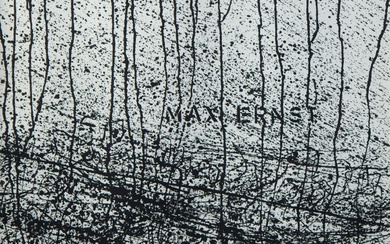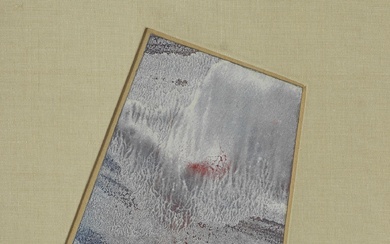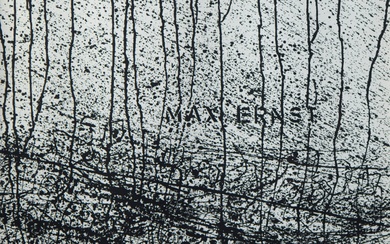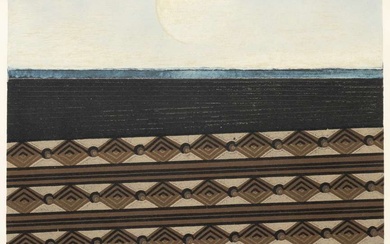MAX ERNST, (1891-1976)
Comète
Comète
signed and dated 'Max Ernst 51' (lower right); signed, inscribed and dated 'Comète, 1951, Ernst' (on the reverse)
oil on canvas
61.2 x 101.5cm (24 1/8 x 39 15/16in).
Painted in 1951
The authenticity of this work has kindly been confirmed by Dr. Jürgen Pech.
Provenance
Max Ernst Collection.
Dorothea Tanning Collection, US (by descent from the above).
Thence by descent to the present owner.
Literature
W. Spies, S. & G. Metken, Max Ernst Œuvre-Katalog, Vol. V, Werke 1939-1953, Cologne, 1987, no. 2884 (illustrated p. 298; with incorrect cataloguing).
'I never lose touch with the world around me' - Max Ernst
The present work Comète refers to Ernst's interest in astrology, which can be traced back through his early oeuvre. Imagery of the cosmos with the earth, sun, moon and the sky can be seen in examples as early as 1909, such as Landschaft mit Sonne. Ever since the subject has remained important throughout his career. 'When you walk through the woods keeping your eyes fixed on the ground, you will doubtless discover many wonderful, miraculous things. But when you suddenly look upwards into the sky, you are overcome by the revelation of another, equally miraculous world. Over the past century the significance of suns, moons, constellations, nebulae, galaxies and all of outer space beyond the terrestrial zone has increasingly entered human consciousness, as it has taken root in my own work and will very probably remain there' (Max Ernst quoted in W. Spies (ed.), Max Ernst: A Retrospective, Munich, 1991 p. 10).
Comète was painted in 1951 during Ernst's last years living in exile. Ernst fled to America in 1941 to escape a second arrest by the Gestapo and settled in New York with other European emigré artists such as André Breton, Amadée Ozenfant, Yves Tanguy and Fernand Léger. After a short marriage to Peggy Guggenheim, he met Dorothea Tanning with whom he would stay for the rest of his life. After a few years the couple decided to escape New York and settled in the desert of Arizona in 1945. Ernst's new surroundings were transformative for his art as the starry nights in the Sedona desert took him to otherworldly imagery.
During the interbellum years Ernst's fantastical pictures had mainly focused on images of brutality and destruction. His visual lexicon propagated a degree of ominousness and discomfort that can be seen in the work Orobas from 1942, where the viewer is presented with a daunting landscape in decay. However, after the Second World War, the artistic landscape had changed. On a visit to Paris in 1950 Ernst noticed that everyone was focused on post-war American art: 'I came back to France at a time when...the terribles simplificateurs were busy praising only abstract art and condemning Surrealist art, especially if it was at all figurative, as too literary, so that it appeared to be irretrievably discredited' (Max Ernst quoted in W. Spies (ed.), Max Ernst Retrospective, exh. cat., Ostfildern, 2013, p. 279). Ernst's outlook changed and he began to adopt theories from American artists who had a more formal approach to painting.
In the present work Ernst embraced abstraction to a certain degree, by treating the canvas as a flat surface onto which he created a playful, almost childlike, image of the cosmos. Ernst flattened the image by constructing the composition through fluid colour arrangements. The glowing sphere of the comet dominates the centre and appears to have facial features, each element composed of small dabs of paint which are enhanced with black outlines. The swirling atmosphere is moving in a counter-clockwise direction, starting with swift brush strokes executed in dark blue and burgundy tones around the comet. The flowing strokes gradually move outwards and change into divisionist touches of fiery red, hot orange and green which echo the speed of light. The foreground is executed in a symphony of dark blue and green hues, that stand in stark contrast to the brightly coloured whirling cosmos, like the sun and the moon.
Ernst's choice of bright colours in Comète is not a coincidence as his palette changed during the post-war years. Muted greys, greens and blues were substituted by more vibrant and uplifting hues, resembling the mesmerising colours of the Sedonian landscape. His new surroundings not only allowed Ernst to reconsider his colour scheme, but he also felt a new sense of optimism to return home during this period. Just the year before Comète was executed, Ernst visited France for the first time since 1941 and was able to witness Europe's recovery with his own eyes. It was not until 1953 when Ernst and Tanning were able to return to France for good, that Ernst continued to work on a series of cosmological paintings in his revived palette.
View it on
Sale price
Estimate
Time, Location
Auction House
Comète
Comète
signed and dated 'Max Ernst 51' (lower right); signed, inscribed and dated 'Comète, 1951, Ernst' (on the reverse)
oil on canvas
61.2 x 101.5cm (24 1/8 x 39 15/16in).
Painted in 1951
The authenticity of this work has kindly been confirmed by Dr. Jürgen Pech.
Provenance
Max Ernst Collection.
Dorothea Tanning Collection, US (by descent from the above).
Thence by descent to the present owner.
Literature
W. Spies, S. & G. Metken, Max Ernst Œuvre-Katalog, Vol. V, Werke 1939-1953, Cologne, 1987, no. 2884 (illustrated p. 298; with incorrect cataloguing).
'I never lose touch with the world around me' - Max Ernst
The present work Comète refers to Ernst's interest in astrology, which can be traced back through his early oeuvre. Imagery of the cosmos with the earth, sun, moon and the sky can be seen in examples as early as 1909, such as Landschaft mit Sonne. Ever since the subject has remained important throughout his career. 'When you walk through the woods keeping your eyes fixed on the ground, you will doubtless discover many wonderful, miraculous things. But when you suddenly look upwards into the sky, you are overcome by the revelation of another, equally miraculous world. Over the past century the significance of suns, moons, constellations, nebulae, galaxies and all of outer space beyond the terrestrial zone has increasingly entered human consciousness, as it has taken root in my own work and will very probably remain there' (Max Ernst quoted in W. Spies (ed.), Max Ernst: A Retrospective, Munich, 1991 p. 10).
Comète was painted in 1951 during Ernst's last years living in exile. Ernst fled to America in 1941 to escape a second arrest by the Gestapo and settled in New York with other European emigré artists such as André Breton, Amadée Ozenfant, Yves Tanguy and Fernand Léger. After a short marriage to Peggy Guggenheim, he met Dorothea Tanning with whom he would stay for the rest of his life. After a few years the couple decided to escape New York and settled in the desert of Arizona in 1945. Ernst's new surroundings were transformative for his art as the starry nights in the Sedona desert took him to otherworldly imagery.
During the interbellum years Ernst's fantastical pictures had mainly focused on images of brutality and destruction. His visual lexicon propagated a degree of ominousness and discomfort that can be seen in the work Orobas from 1942, where the viewer is presented with a daunting landscape in decay. However, after the Second World War, the artistic landscape had changed. On a visit to Paris in 1950 Ernst noticed that everyone was focused on post-war American art: 'I came back to France at a time when...the terribles simplificateurs were busy praising only abstract art and condemning Surrealist art, especially if it was at all figurative, as too literary, so that it appeared to be irretrievably discredited' (Max Ernst quoted in W. Spies (ed.), Max Ernst Retrospective, exh. cat., Ostfildern, 2013, p. 279). Ernst's outlook changed and he began to adopt theories from American artists who had a more formal approach to painting.
In the present work Ernst embraced abstraction to a certain degree, by treating the canvas as a flat surface onto which he created a playful, almost childlike, image of the cosmos. Ernst flattened the image by constructing the composition through fluid colour arrangements. The glowing sphere of the comet dominates the centre and appears to have facial features, each element composed of small dabs of paint which are enhanced with black outlines. The swirling atmosphere is moving in a counter-clockwise direction, starting with swift brush strokes executed in dark blue and burgundy tones around the comet. The flowing strokes gradually move outwards and change into divisionist touches of fiery red, hot orange and green which echo the speed of light. The foreground is executed in a symphony of dark blue and green hues, that stand in stark contrast to the brightly coloured whirling cosmos, like the sun and the moon.
Ernst's choice of bright colours in Comète is not a coincidence as his palette changed during the post-war years. Muted greys, greens and blues were substituted by more vibrant and uplifting hues, resembling the mesmerising colours of the Sedonian landscape. His new surroundings not only allowed Ernst to reconsider his colour scheme, but he also felt a new sense of optimism to return home during this period. Just the year before Comète was executed, Ernst visited France for the first time since 1941 and was able to witness Europe's recovery with his own eyes. It was not until 1953 when Ernst and Tanning were able to return to France for good, that Ernst continued to work on a series of cosmological paintings in his revived palette.







